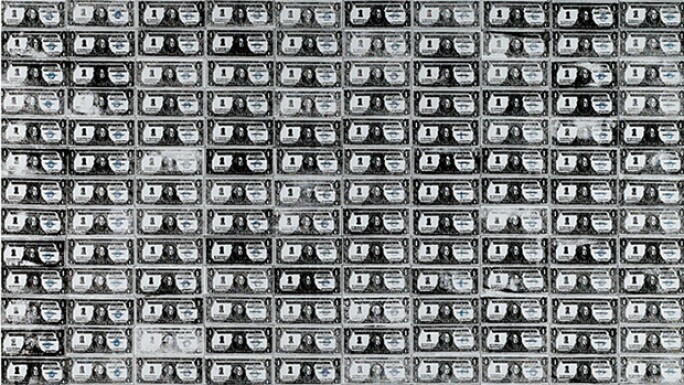
Andy Warhol's 200 One Dollar Bills sold at Sotheby's in 2009 for $43.8 million.
21 Days of Andy Warhol is Sotheby’s three-week celebration of the essential 20th century artist with one-a-day stories and videos about Warhol’s origins, influences, inspirations, all leading up to the sale of important Warhol pieces in our Contemporary Art Evening auction 13 November.
NEW YORK - The November 2009 Sotheby's sale of Andy Warhol's 200 One Dollar Bills (1962) stands as a major milestone in the history of not only the artist's work at auction, but also the ever-fluctuating global market for contemporary art. Estimated to fetch between $8 million and $12 million, 200 One Dollar Bills inspired aggressive bidding that elevated the price well beyond its high estimate to a remarkable $43.8 million. The sale set a record that still stands today as the highest price ever reached for any Andy Warhol work auctioned at Sotheby's.
"It was one of those auction moments that you like to see, with something totally fresh to the market, completely important through its provenance, through its place in the artist's body of work," recalls Leslie Prouty, a Sotheby's senior vice president and senior specialist in its Contemporary Art Department. "But you have to remember, it was November of 2009."
In the fall of 2008, economies around the world were in upheaval as the United States suffered a dire fiscal crisis. Auction houses like Sotheby's were quick to adjust their estimates in response to the suddenly turbulent economic waters. So for the market to rebound as fast and as definitively as it did was a welcome surprise.
"This is the classic example of the owner having faith in the painting and in the process," Prouty continues. "So the estimate of $8 million to $12 million wasn't shy, but it certainly didn't reflect where it would ultimately sell for." She adds, "Considering the market that we were selling it in, that just tells you how extraordinary the moment was and how extraordinary the piece was."
200 One Dollar Bills once belonged to the notable Pop Art collector Robert C. Scull. When Sotheby's posthumously auctioned off his estate in November 1986, the painting was purchased for $383,000 by a private collector. It went unexhibited for the following 23 years while in possess of the buyer. "It had truly been quietly off the market," Prouty notes.
Aptly named, 200 One Dollar Bills depicts a vast, 20-by-10 grid of $1 bills. The painting belongs to Warhol's famous Dollar Bill series, which marks the first instance of Warhol's use of the silk-screening method. At this early stage in his experimentation with the technique, Warhol had not yet progressed to the point where he was transferring images photographically to the screens—the images of currency are based on the artist's drawings and thus provide a glimpse of Warhol's hand as a draughtsman. Prouty says that within the Dollar Bill series, Warhol only created 10 paintings in this repetitive format – that is, depicting more than two bills on a single canvas. 200 One Dollar Bills is one of the two largest of those 10; the other, entitled 192 One Dollar Bills, belongs to the Marx Collection and hangs in a Berlin museum.
Tomorrow: Andy and Double Elvis